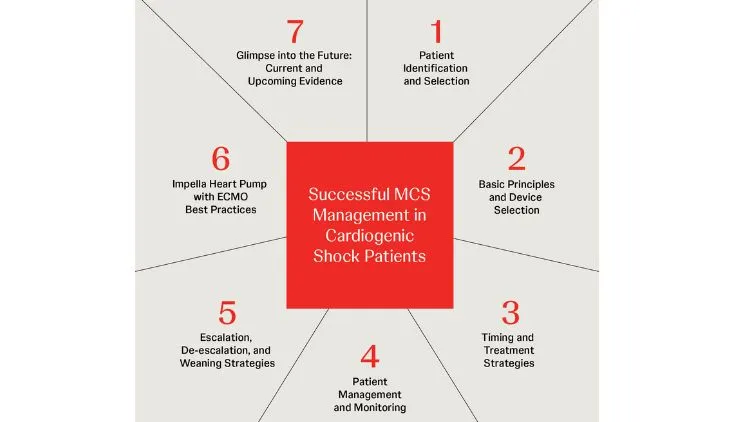AMI Cardiogenic Shock
Developing Best Practices for Managing AMI Cardiogenic Shock
“What are the foundations for developing best practices in managing AMI cardiogenic shock?” asks William O’Neill, MD, as he begins this presentation of data and the ways in which high-performing institutions are improving survival in patients with AMI cardiogenic shock.
“If you’re going to be using Impella®, you need to use it early, you need to use it before you do the percutaneous intervention,” Dr. O’Neill states. “You can see that in the subgroups in the CULPRIT-SHOCK trial, the survival really is significantly increased in the subgroups when the artery is open before the intervention is performed.”
Dr. O’Neill shares AMI cardiogenic shock survival data demonstrating that median survival to Impella explant has increased from 51% to 75%. Noting this dramatic 25% increase in survival in just three years, he explains that hospitals are systemizing practices and organizing protocols to treat patients more uniformly. “Now we have sites that are routinely getting 100% survival for management of AMI shock,” he explains. “We really want to try to understand what is it about these high-performing institutions that are associated with an improvement in survival.”
Presenting the NCSI algorithm, Dr. O’Neill emphasizes the importance of supporting patients quickly. “Get them supported. Get them unloaded. Our target is to get the door to support time less than 90 minutes. Not door to balloon. Door to support.” He reminds us that in shock, door-to-balloon time does not count, so that should not deter quick implementation of Impella support, which is incredibly important for patient outcomes. Other best practices he emphasizes are considering RV support, if needed, and ensuring that patients leave the cath lab with adequate blood flow down the leg.
In his review of NCSI data to date, Dr. O’Neill explains that 80% to 90% of patients are receiving Impella pre-PCI and door to support time averages 93 minutes. In addition, TIMI 3 flow is established in 90% of cases. “And I think that’s actually one of the most powerful and under recognized prognostic signs,” Dr. O’Neill explains. “If you take a look at all the other literature, in the SHOCK trial and other shock studies, usual TIMI 3 flow rates are around 80%. So, we’re actually already showing some benefit by pre-reperfusion support, by getting the blood flow up to TIMI 3 flow.”
Looking at hemodynamic trends, Dr. O’Neill reports that prior to support, patients had a mean CPO of 0.6 watts, which went up to 0.9 after support and over the next 24 hours. “So, within 24 hours, the vast majority of these patients are already out of shock,” he emphasizes. In addition, he notes that systolic blood pressure significantly increases after the procedure and out to 24 hours. Creatinine stabilizes, which is important since one of the major causes of death in AMI shock is acute kidney injury. Lactate consistently goes down from very elevated at the start of the procedure to washing out by 24 hours. “That’s what we’d like to have you see in your patients,” Dr. O’Neill tells the audience.
Dr. O’Neill emphasizes that looking at these hemodynamic parameters is essential. “We want to try to get them out of shock as soon as possible to prevent end-organ damage and end-organ hypo-perfusion and all the systematic inflammatory response that happens afterwards.”
Dr. O’Neill reviews how hemodynamics can be used to predict prognosis, with the highest survival rates (93%) in patients with CPO >0.6 and no inotropes immediately following mechanical circulatory support and PCI, and the worst prognosis (survival 25%) in patients with CPO ≤0.6 who are on two or more inotropes. He also looks at lactate as a predictor or survival at 12-24 hours. Survival was highest (94%) in patients with lactate <4 and CPO >0.6. Survival was lowest (28%) in patients with lactate ≥4 and CPO ≤0.6.
He concludes with a brief discussion of escalation strategies, which depend on local expertise and the facilities at each institution. He emphasizes the importance of planning escalation strategies and “pulling the trigger” on them within 12-24 hours when you know the trajectory of outcome for these patients. He explains that the next goal is to see whether systematic early escalation of care further improves survival.
NPS-577


